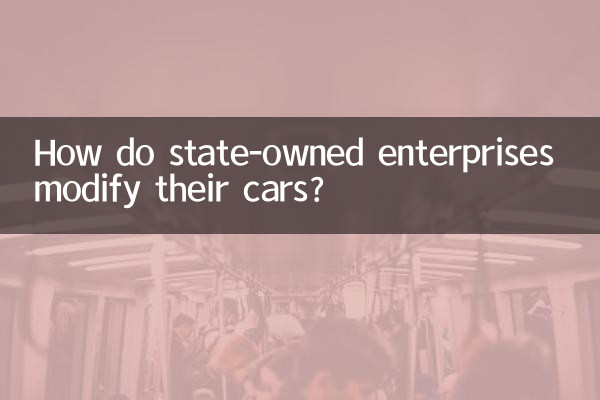State-owned vehicle modification: current situation, challenges and future paths
In recent years, the reform of state-owned enterprises has become a hot topic of social concern. With the deepening of public vehicle reform, how state-owned enterprises optimize official vehicle management, reduce operating costs, and improve efficiency has become the focus of discussion among all parties. This article will combine the hot topics and hot content on the Internet in the past 10 days to conduct a structured analysis of the current situation, problems and future directions of state-owned enterprise vehicle reform.
1. Background and Current Situation of State-owned Enterprise Vehicle Reform

The reform of state-owned enterprises is an important part of the public vehicle reform, which aims to optimize resource allocation and reduce waste through market-oriented means. According to public data, current state-owned enterprise car modifications mainly present the following characteristics:
| project | data | illustrate |
|---|---|---|
| Number of state-owned buses | About 500,000 vehicles | Accounting for about 30% of the total number of buses in the country |
| Car modification coverage | 60%-70% | Central enterprises are higher than local state-owned enterprises |
| average annual cost savings | 15%-20% | Some companies have greater savings |
2. Main modes of vehicle modification for state-owned enterprises
Judging from recent hot discussions, state-owned enterprises mainly adopt the following modes of vehicle reform:
| model | Features | Representative enterprise |
|---|---|---|
| monetization reform | Cancel special cars and issue transportation subsidies | PetroChina, Sinopec |
| Sharing reform | Establish an internal sharing platform | State Grid, China Mobile |
| social reform | Outsourcing to third-party service providers | Some provincial state-owned enterprises |
3. Challenges faced by state-owned enterprises in vehicle reform
Although certain results have been achieved, state-owned enterprise vehicle reform still faces many challenges:
1.Inconsistency in ideological understanding: Some leading cadres are resistant to vehicle modification and believe that it will affect work efficiency.
2.Subsidy standards are unscientific: Subsidies vary greatly from place to place. Some are too high, raising questions, and some are too low, making it difficult to meet demand.
3.The regulatory mechanism is not sound: There is a phenomenon of "taking subsidies and using cars at the same time", and illegal use problems occur from time to time.
4.Supporting measures are incomplete: Especially in remote areas, public transportation is underdeveloped, which affects the effectiveness of the reform.
4. The future direction of vehicle modification for state-owned enterprises
Based on recent hot topics of discussion, state-owned enterprise vehicle reform may develop in the following directions in the future:
| direction | Specific measures | expected effect |
|---|---|---|
| Digital management | Establish an intelligent dispatching system | Improve vehicle usage efficiency |
| New energy alternative | Accelerate the update of electric vehicles | Reduce operating costs |
| Market-oriented operation | Introduce competition mechanism | Improve service quality |
5. Typical case analysis
Two typical cases that have attracted recent attention:
1.China Construction Group vehicle modification: By establishing a "bus sharing platform", the vehicle utilization rate will be increased by 40%, and the annual cost savings will exceed 20 million yuan.
2.Car modification by a provincial state-owned enterprise: Public opinion questioned the excessively high subsidy standards, and the final adjustment plan reflected the sensitivity of standard setting.
6. Policy recommendations
Based on current reform practice, the following suggestions are put forward:
1. Develop differentiated subsidy standards, taking factors such as region and position into consideration.
2. Strengthen supervision and inspection and establish an accountability mechanism for illegal vehicle use.
3. Improve supporting measures, especially to solve the problem of car use in remote areas.
4. Promote the integration of vehicle modification and the digital transformation of state-owned enterprises.
Conclusion
Vehicle modification for state-owned enterprises is a systematic project that requires a balance between efficiency, cost and fairness. Judging from recent hot discussions, all sectors of society generally recognize the effectiveness of the reform, but also look forward to further improvements. In the future, with the deepening of reform, the management of official vehicles of state-owned enterprises will be more standardized, efficient and transparent.

check the details

check the details